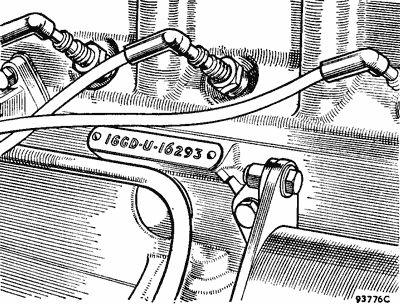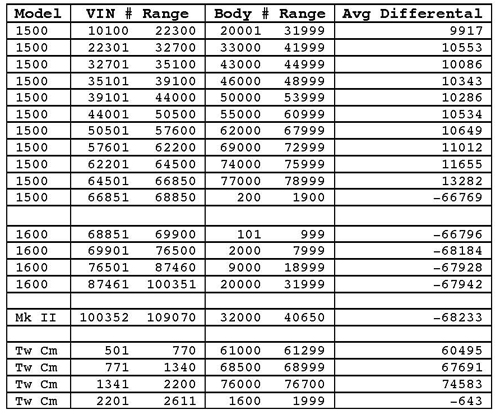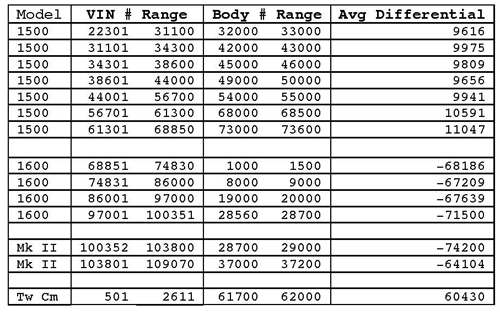MGA Chassis (VIN), Engine & Body Numbers

 This updated column is a reprint of an article that first appeared in the March/April 1991 issue of MGA! by then Registrar Bill Gallihugh, and then subsequently reprinted in MGA! an additional 3 times over the years.
This updated column is a reprint of an article that first appeared in the March/April 1991 issue of MGA! by then Registrar Bill Gallihugh, and then subsequently reprinted in MGA! an additional 3 times over the years.
Bill’s statistical data was used in the book Original MGA by Andres Clausager, and was reprinted in Safety Fast in a June 1991 article. It has also been reprinted in Dutch and appeared in an article there. This article may help to educate and inform many who have questions of the correlation between VIN Numbers, Engine Numbers and Body Numbers.
As Registrar, I received about two questions a week regarding serial numbers:
- Is my engine original?
- How can I tell if my ID plate belongs to my MGA?
- I have only a partial chassis number, how can I determine the proper number?
All of this relates in one way or another to the relationship between the three primary serial numbers found on an MGA: the Chassis Number, Engine Number, and Body Number. (For simplicity, I shall refer to the Chassis Number as the Vehicle Identification Number, or VIN.) Apparently, Abingdon did not bother to help us out by keeping track of any number other than the VIN. So how do we determine the association between the three?
It occurred to me some time ago that with over 4,200 MGAs and Variants now registered with NAMGAR, we should be able to get printouts from the NAMGAR database that would lead to some useful conclusions – or at least some generalizations. When I finally set myself to this task, it turned out to be rather more difficult than I had imagined. It took quite a number of programs to extract the data in a meaningful way, and to do the necessary calculations. Then there was a lot of pencil work to collate, plot, and categorize the information so that a few rules might be established. Following are the results of that effort. It is not necessarily intended as interesting reading, but rather as a future reference source to answer questions such as those raised above.

First a few ground rules. The best way to deal with the serial number relationships is to use the VIN as the base number, and think of the engine and body numbers as running so much higher or lower than the VIN number. For instance, if we say the engine numbers are running at -9000, we mean that for the range of numbers being investigated, the engine number will average 9000 less than the VIN. If the VIN is 55000, the engine number would be approximately 46000. To go the other direction, just reverse the sign. And speaking of ‘approximately,’ I’ll be using that word a lot. Please accept that some of the number range limits in the tables below are guesstimates.
Engine Number
A few general observations about engine numbers:
- Coupe engine numbers seem to run in the same range as Roadsters. In 1600s and Mk IIs, the average Coupe engine number runs about 150 below that for the average Roadster, but this could be due to a sampling error because of the limited number of Coupes registered. In any event, I won’t complicate things even more by trying to separate Coupes from Roadsters.
- Mk II Deluxes do not show a significant variation in engine number sequences from the standard 1500, 1600, or Mk II.

Now for the meat of the data. First of all, it is quite obvious that there is not a strict one-for-one relationship between the VIN and the engine number. That is, the engines were not placed into the waiting chassis in numerical order according to the engine number. One might imagine a room full of engines awaiting installation, and whichever one was closest to the door got installed first. But within this chaos a general pattern exists, and the engines are, if one squints rather hard, in some kind of overall numerical order. That order is sufficient to make some generalizations based on the following analysis:
After eliminating engine numbers from apparent replacement engines, it is fairly simple to determine the average differential between the VINs and the engine numbers. (As in the example above, the average differential might be -9000.) The big question is how much deviation is there from this average difference, and how can we quantify it.
If one examines and plots these deviations from the average, a “bell curve” is established. At the apex of the curve is the average VIN/engine number differential, and the slope on either side depicts the percentage of engine numbers that are either higher or lower than the standard average. Most engine numbers fall within a range of about 400 numbers, or +/- 200 from the average differential.
If you add or subtract (as indicated) the average differential from/to the VIN, the probability of hitting the actual engine number can be represented as:
• 38% probability of being within +/- 50
• 64% probability of being within +/- 100
• 85% probability of being within +/- 200
Before listing the computed average differentials, one additional item that came to light should be discussed. In 1500s with GB engines, the differential starts at about -9900, and ends up (at VIN 61503) at about -9700. This means that over this range of 51,402 MGAs, approximately 200 engines (or at least engine numbers) did not find their way into an MGA. To allow for this, I’ve divided 1500s with GB engines into three sub groups to get a more accurate average differential.
As an example for using the table, if you have an MGA with a VIN of 94355, we can see that your engine if it is to be original be a type GA (16GA), and must be in the range of 101 to 31660. More specifically, it will most likely be approximately 25655 (94355 minus 68700).
In actual fact, this is my 1600, and the actual engine number (which I think to be original) is 25389, a difference of 266. That makes it in the 15% that falls outside the 200 range indicated above. Applying this test to my Mk II, the computed engine number is only 71 off the actual, making it in the 64% probability range.
Average Differential Between VIN # and Engine #

*Some factory data I’ve seen shows that the last GC engine was 8618. However, this is apparently wrong as we have several Mark II’s registered with numbers higher than this – including the very last MGA ever produced – VIN 109070, Engine number 8846.
Body Numbers
Establishing the relationshp of body serial numbers to the VIN is far more complicated and uncertain because the method used by Abingdon to assign body numbers to Twin Cam Roadsters and all Coupe bodies made a mess of the system. Basically, what they apparently did was to periodically reserve blocks of 1000 numbers from the main sequence of 1500 and 1600 body numbers – and then assign them to the Twin Cams and Coupes. If one studies the tables below, one can see the missing body number blocks from the 1500/1600 Roadster sequences, and then find them reappearing again as Twin Cam and Coupe body number ranges.
As a result of all this, it is even more problematic to establish VIN/body number relationships that with VINs and engine numbers. You can use the Average Differentials listed in the tables below to go from VIN to body number (or visa versa), but the results are even less certain. For my 1600, with a VIN of 94355, we would subtract 66769 and end up with a predicted body number of 27586. In actual fact it is 25389. Close…..
A couple of general notes: 1) Deluxes tend to have a body number about 2000 higher than standard Mk IIs for the same VIN range; 2) the “B” prefix on some body numbers does not effect the number sequences.
VIN # and Body # – ROADSTER

VIN # and Body # – COUPE

Author’s Postscript:
In 2013, with over 8100 MGAs now registered, I reprocessed the numbers to see if I could refine the above conclusions somewhat. While I was able to get closer on some of the ranges shown (particularly for body numbers), the (apparently) haphazard manner in which MGAs were assembled means that even with the larger sample base now available, we are left with the unavoidable conclusion: Given one, or even two, of the MGA serial numbers will not lead you definitely to the third. Sorry…..

